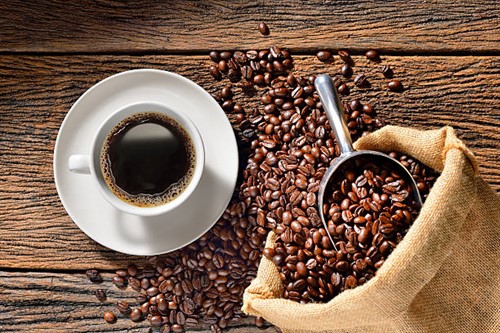Many people credit coffee (the most popular caffeinated beverage for Americans), sodas like Diet Coke and even energy drinks for providing them the boost they need to get through their day, whether that's first thing in the morning or when that 3 p.m. slump hits.
According to the American Medical Association, about 85% of U.S. adults consume 135 milligrams of caffeine daily, which is roughly the amount in a 12-ounce cup of coffee. While no one is suggesting parting ways with your daily cup of joe, which is good for you, there are some benefits to scaling back on caffeine. Here’s why it's a good idea for some — and how to do it.
Why you may want to cut back on caffeine
Dr. Rohit Vuppuluri, an interventional cardiologist, tells Yahoo Life that caffeine is safe to use in moderation — less than 400 mg per day, according to the FDA, which is the equivalent of about two or three 12-ounce cups of coffee. Some reports show caffeine may have health benefits including improved cognitive function as well as reduced risk of diseases like Parkinson’s and type 2 diabetes.
However, caffeine, particularly when it’s overused, can cause unwanted side effects like “insomnia, digestive problems, increased blood pressure and faster heart rates,” Vuppuluri says. In very rare cases, too much caffeine can be fatal.
One of the biggest downsides of caffeine is the potential to disrupt your sleep, especially if you drink it closer to bedtime. Dr. Laura Purdy, a specialist in family medicine, tells Yahoo Life that, in general, caffeine stays in your body for about five hours. But for some, it can last even longer. That can make it harder to doze off or stay asleep, getting in the way of a good night’s rest. And when you don’t sleep well, you’re more likely to reach for caffeine to stay alert the next day, creating a bit of a vicious cycle.
How to cut back on caffeine
If you’re trying to consume less caffeine or wean yourself off entirely, you may experience some withdrawal symptoms, especially if you are a regular drinker. Purdy says that this can look like “brain fog, fatigue, irritability and difficulties concentrating, along with headaches.” These symptoms can start within the first 12 hours without caffeine and can last up to 10 days.
Here are some expert tips for cutting back:
Set a realistic goal
Vuppuluri says it’s important to assess how much caffeine you are drinking daily, and then set a goal for how much coffee you want to consume. So if you regularly drink four cups of coffee a day, you can make it a goal to scale back to just one in the morning — and give yourself a week or two to reach that target by slowly tapering off the number of coffees you drink in a day over time.
Cut out afternoon caffeine first
Many people reach for caffeine in the morning as a pick-me-up, so if you’re just starting to reduce your caffeine intake, try cutting it out in the afternoon first, Tiffany Ma, a sports medicine dietitian, tells Yahoo Life. This can ultimately stop that vicious cycle of not getting enough sleep because of caffeine and then fueling yourself with more caffeine the next day to stay alert.
Don’t change up too much at once
Sometimes a caffeine habit is part of a pleasant routine, like drinking a warm cup of coffee in the morning while reading the newspaper. If you cut out coffee entirely, you may miss out on not just its energizing effects, but also the happiness boost of your morning ritual. Instead, Vuppuluri says, you can gradually reduce your caffeine intake with simple steps — like mixing your regular coffee with decaf. You can then use less and less caffeine over time.
If soda is your vice, swap out your caffeinated cola for a caffeine-free variety. Same goes for tea: While green, white, oolong and black teas have caffeine (albeit less than coffee does at 14 to 60 mg per cup), herbal teas are naturally decaffeinated and therefore options if you’re looking to sip something warm.
Switch to a lower-caffeine version of your favorites
If your goal isn’t to cut out caffeine entirely, you can switch to beverages that have less caffeine overall, and make them a part of your permanent routine. Purdy suggests swapping a highly caffeinated drink to one with less caffeine, such as green tea in place of coffee, which has about 30 to 50 mg of caffeine per cup compared with coffee’s 70 to 140 mg per typical brewed cup.
Manage your withdrawal symptoms
Vuppuluri recommends paying attention to withdrawal symptoms, such as headaches, fatigue or irritability, which are common when reducing caffeine intake. Preparing for these symptoms may stop you from reaching for another cup of coffee in order to stave off the side effects.
First, manage your stress and sleep, which can make all of these symptoms feel much worse. If you’re experiencing headaches, you can pop an over-the-counter pain reliever and drink plenty of water to avoid dehydration — especially if your caffeinated beverages were a major part of your daily liquid intake.
Since caffeine is a stimulant, you also may feel out of sorts, unmotivated or even a bit grumpy when cutting back. This is because caffeine temporarily increases dopamine levels, a neurotransmitter that plays a role in mood, motivation and happiness, and reducing caffeine can lead to a drop in these levels. Physical activity — like going for a walk or taking your favorite exercise class — can help combat these symptoms.
Withdrawal symptoms are also temporary: The unpleasant effects should dissipate in 10 days, after which, you may find that you’re not so inclined to reach for that cup of joe.
(Yahoo)





